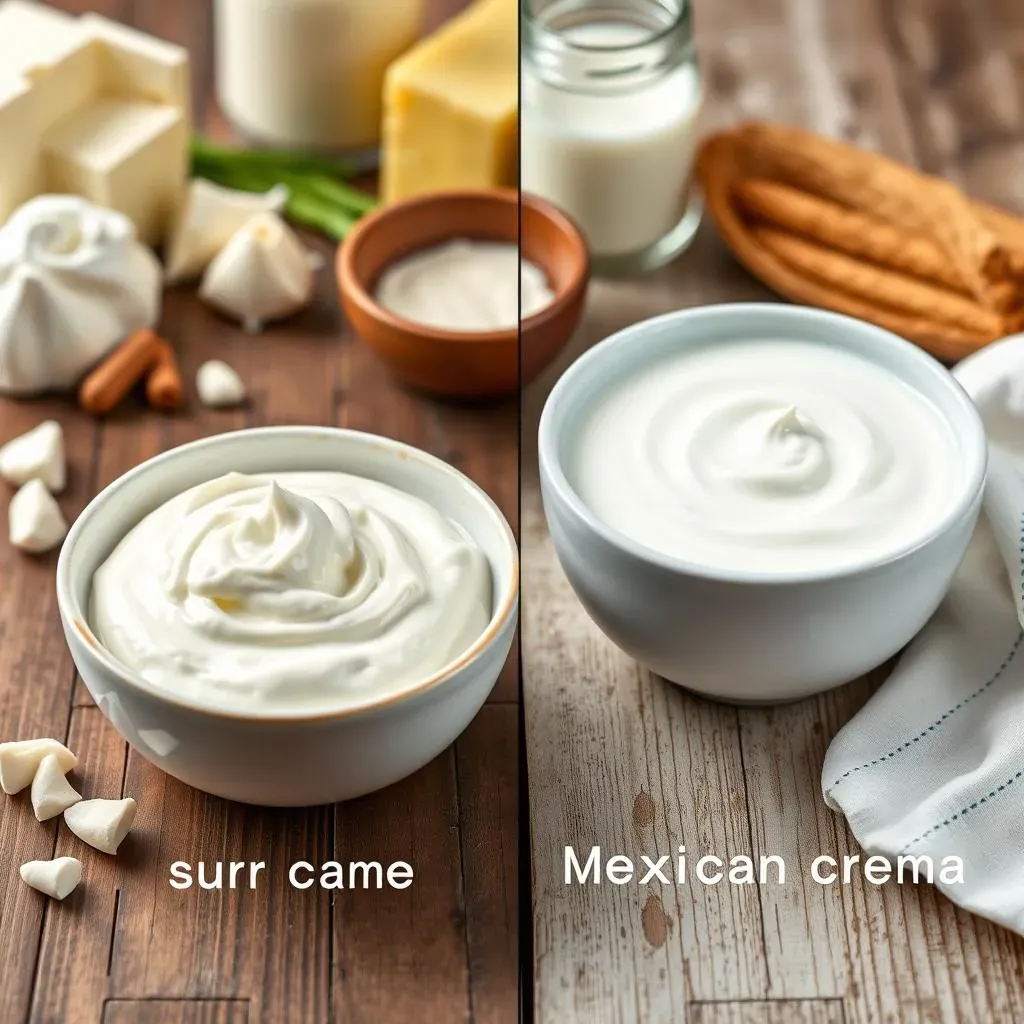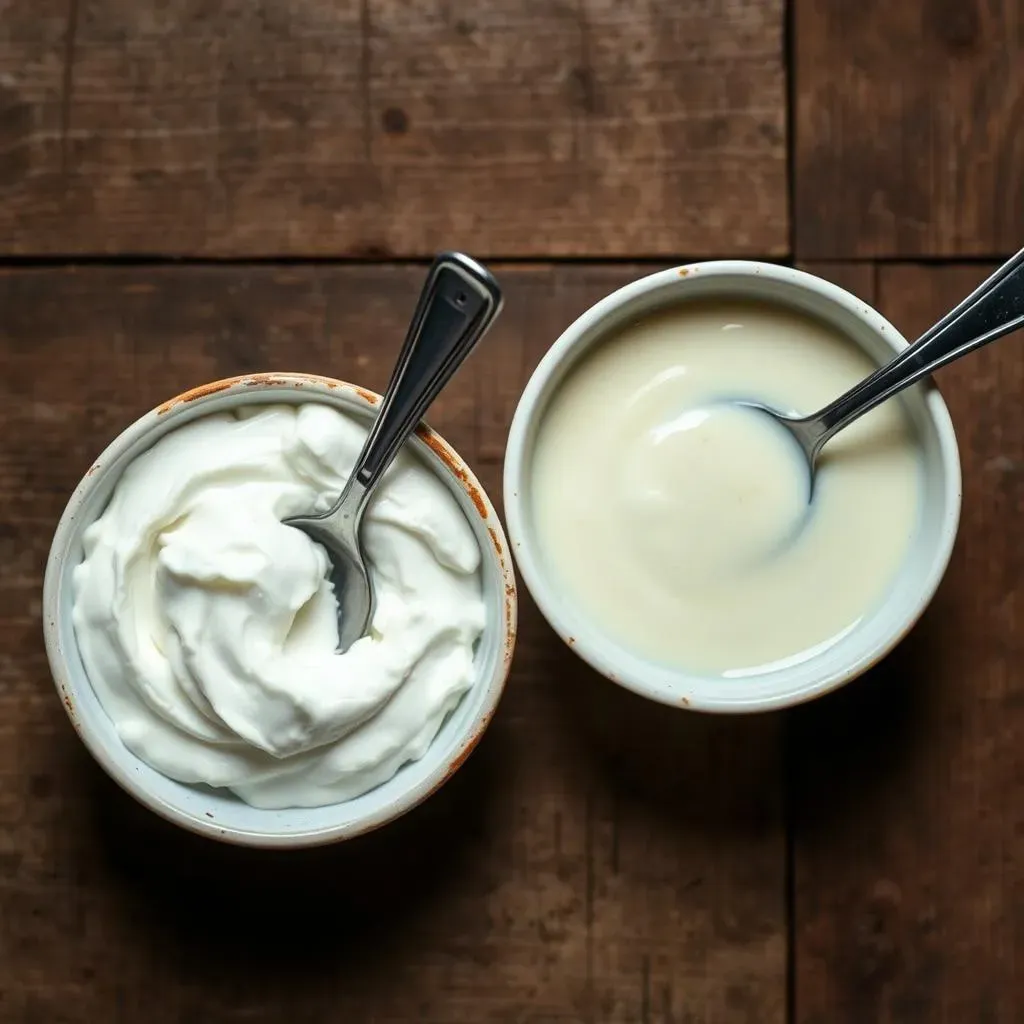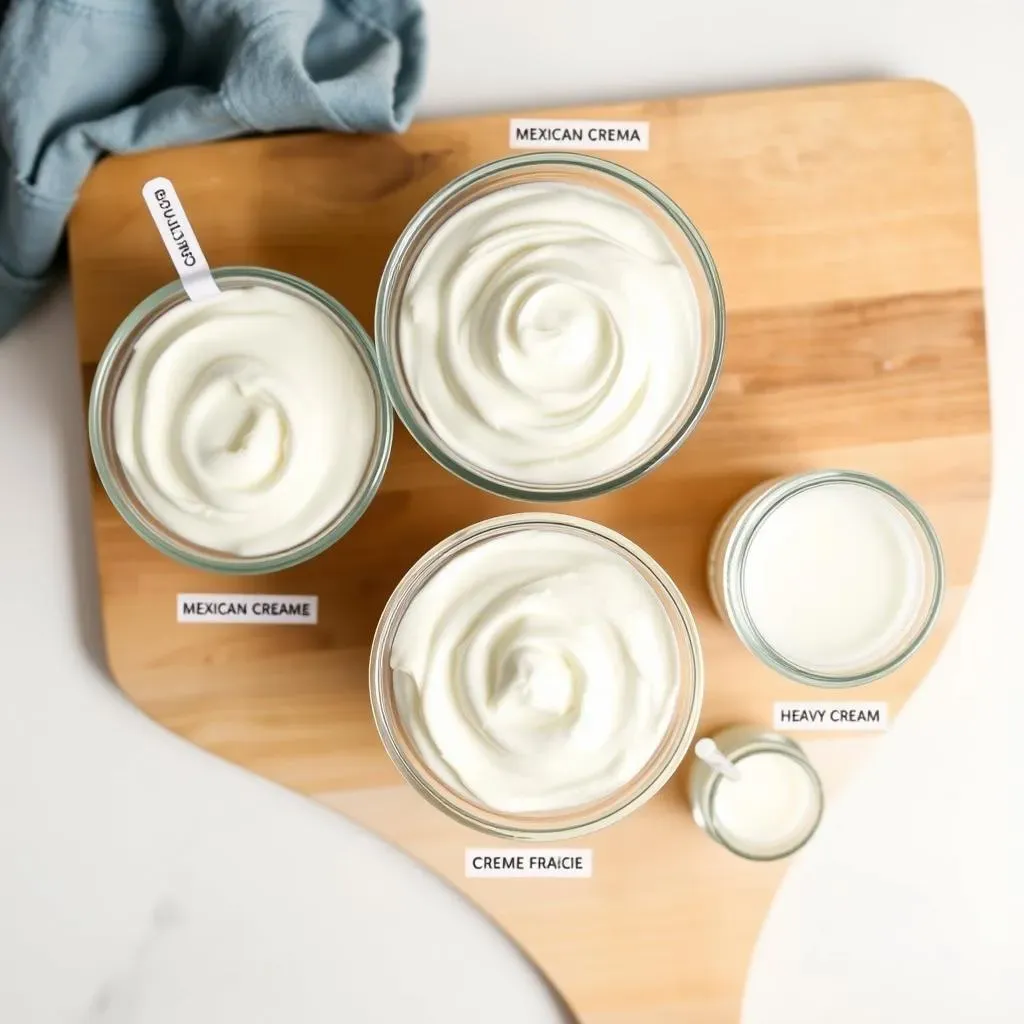Table of Contents
Ever stared blankly at the dairy aisle, wondering what the heck the difference is between Mexican table cream vs sour cream? You're not alone! These two creamy delights often get mixed up, but they each bring something unique to the table, especially when we're talking about authentic Mexican flavors. Think of it this way: sour cream is like that reliable friend who's always there for taco night, while Mexican table cream, or crema, is the cool cousin who shows up with a slightly tangy, richer vibe. This article will break down the basics of these two ingredients, from their flavor profiles and textures to when you should reach for one over the other in your culinary adventures. Get ready to become a crema and sour cream connoisseur, and maybe even impress your friends with your newfound dairy knowledge!
Sour Cream and Mexican Table Cream: What Are They?

Sour Cream and Mexican Table Cream: What Are They?
Sour Cream: The Tangy Classic
Sour cream, that familiar dollop of goodness, starts with regular cream. Then, some friendly bacteria—lactic acid bacteria—are added to the mix. These little guys ferment the cream, which means they eat up some of the sugars and produce lactic acid. This is what gives sour cream its signature tangy flavor and thick texture. Think of it like making yogurt, but with cream instead of milk!
You'll often find sour cream chilling in the refrigerated section of your grocery store, ready to top your baked potatoes, tacos, or even swirl into soups. It's a versatile ingredient that adds a creamy, slightly acidic counterpoint to rich or spicy dishes.
Mexican Table Cream (Crema): A Milder Sibling
Now, let's talk about Mexican table cream, also known as crema. Crema is also made by fermenting cream, but with a slightly different process and different cultures. Typically, it involves a combination of heavy cream and buttermilk. The result? A cream that's milder and a touch sweeter than sour cream.
Crema has a thinner consistency compared to sour cream, making it easy to drizzle over your favorite Mexican dishes. It's like the cool, laid-back cousin of sour cream, bringing a subtle richness without the intense tang.
Feature | Sour Cream | Mexican Table Cream (Crema) |
|---|---|---|
Main Ingredients | Cream, Lactic Acid Bacteria | Heavy Cream, Buttermilk |
Flavor | Tangy, Acidic | Mild, Slightly Sweet |
Consistency | Thick | Thin, Pourable |
Regional Variations and Names
One thing to keep in mind is that both sour cream and crema can have regional variations. In some areas, you might find "crème fraîche," which is similar to sour cream but often richer and less tangy. As for crema, different regions in Mexico have their own versions, some thicker, some more pourable.
Also, the name "Mexican table cream" itself can vary. You might see it labeled as "crema Mexicana" or simply "crema." The key is to check the ingredients and look for that slightly thinner consistency compared to sour cream. Don't be afraid to experiment and find your favorite!
Taste Test: Mexican Table Cream vs. Sour Cream

Taste Test: Mexican Table Cream vs. Sour Cream
Alright, let's get down to the fun part: tasting! Imagine you've got two bowls in front of you, one with sour cream and one with Mexican table cream. The first thing you'll notice is the texture. The sour cream will be thicker, almost like a dense cloud. The crema, on the other hand, will be more like a gentle rain, easily drizzled and smooth. Now, take a spoonful of each. The sour cream will hit you with that unmistakable tang, a zing that wakes up your taste buds. The crema will be subtler, a creamy coolness that whispers sweetness rather than shouts acidity. It's like the difference between a lemon and a lime – both citrus, but with distinct personalities.
Cooking with Crema and Sour Cream: When to Use Which

Cooking with Crema and Sour Cream: When to Use Which
When Sour Cream Shines
Sour cream is your go-to when you want that tangy kick to cut through richness. Think about a loaded baked potato – that dollop of sour cream isn't just for looks! The acidity balances the starchy potato and the fatty bacon and cheese. It works the same way with spicy dishes. The tanginess of sour cream can help cool down the heat of chili or buffalo wings. It's also fantastic in dips, like French onion or ranch, where its flavor can really shine.
However, be careful when adding sour cream to hot dishes that are simmering or boiling. High heat can cause it to curdle or separate, leaving you with a grainy texture. It's best to add it at the very end, off the heat, or use it as a topping.
Crema's Culinary Canvas
Crema, with its milder flavor and thinner consistency, is incredibly versatile in Mexican cuisine. It's perfect for drizzling over tacos, enchiladas, and tostadas, adding a creamy finish without overpowering the other flavors. Crema also works wonders in soups and stews, stirring in smoothly to create a richer, more luxurious texture. Unlike sour cream, crema is more heat-stable, so it's less likely to curdle when added to hot dishes. This makes it a great option for simmering sauces or adding a touch of creaminess to cooked dishes.
Consider crema as the secret ingredient to elevate your salsas and guacamole. A spoonful of crema can mellow out the heat of spicy peppers and add a velvety texture to your favorite dips.
Creative Swaps and Combos
Don't be afraid to experiment! While sour cream and crema have their ideal uses, sometimes you can swap them out depending on your preference. If you want a tangier flavor in your enchiladas, go ahead and use sour cream instead of crema. Or, if you want a milder topping for your baked potato, crema can work too!
You can even combine the two! A mix of sour cream and crema can give you the best of both worlds – a balance of tanginess and creaminess that works in a variety of dishes. Ultimately, the choice is yours, so have fun and find what tastes best to you.
Dish | Best Choice | Why? |
|---|---|---|
Loaded Baked Potato | Sour Cream | Tang cuts through richness |
Tacos | Crema | Milder flavor, easy to drizzle |
Spicy Chili | Sour Cream | Cools down the heat |
Simmering Soups | Crema | Heat-stable, won't curdle |
Elevating Salsas | Crema | Adds velvety Texture |
Mexican Table Cream vs Sour Cream: Your Ultimate Guide

Mexican Table Cream vs Sour Cream: Your Ultimate Guide
Decoding Labels: What to Look For
Navigating the dairy aisle can feel like decoding a secret language. "Reduced fat," "organic," "cultured"—what does it all mean? When you're on the hunt for either sour cream or Mexican table cream, pay close attention to the ingredient list. For sour cream, you should see cream and lactic acid cultures. For crema, look for heavy cream and buttermilk or similar cultures. Also, keep an eye out for additives like stabilizers or preservatives if you prefer a more natural product. Brands like Cacique and Daisy are popular choices, but don't hesitate to explore smaller, local dairies for unique variations.
Here's a quick cheat sheet:
- Sour Cream: Cream, Lactic Acid Cultures
- Crema Mexicana: Heavy Cream, Buttermilk (or cultures)
- Crème Fraîche: Cream, Cultures (often richer)
DIY Crema: The Home Cook's Hack
Feeling adventurous? You can actually make a version of crema at home! It won't be exactly the same as the store-bought kind, but it's a great substitute in a pinch. Simply mix together heavy cream and buttermilk (about a tablespoon of buttermilk per cup of cream), let it sit at room temperature for 24-48 hours until it thickens slightly, and then refrigerate. The buttermilk introduces the cultures needed to ferment the cream, giving you a tangy, pourable cream that's perfect for topping tacos or drizzling over soups. It's a fun and easy way to experiment with flavors and textures in your own kitchen.
Here is a recipe for you:
Ingredients | Amount |
|---|---|
Heavy Cream | 1 cup |
Buttermilk | 1 tablespoon |
Beyond the Basics: Exploring Global Creams
The world of cultured creams extends far beyond sour cream and crema. Crème fraîche, from France, is another popular option, known for its rich, slightly nutty flavor and high fat content. It's often used in both sweet and savory dishes, from topping desserts to enriching sauces. Then there's smetana, a staple in Eastern European cuisine, which is similar to sour cream but often has a higher fat percentage. Each of these creams brings its own unique character to the table, reflecting the culinary traditions of its region. So, next time you're feeling adventurous, why not explore the global landscape of cultured creams and discover new flavors to elevate your cooking?
“The only limit to your impact is your imagination and commitment.” - Tony Robbins
Mexican Table Cream vs. Sour Cream: The Final Scoop
So, there you have it! Mexican table cream and sour cream, while similar, boast distinct personalities that can truly shine in different dishes. Whether you're aiming for a bright, tangy kick or a smooth, slightly sweet finish, knowing the difference between these two dairy stars will seriously level up your cooking game. Now go forth, experiment, and taste the difference for yourself. Your tacos (and taste buds) will thank you!